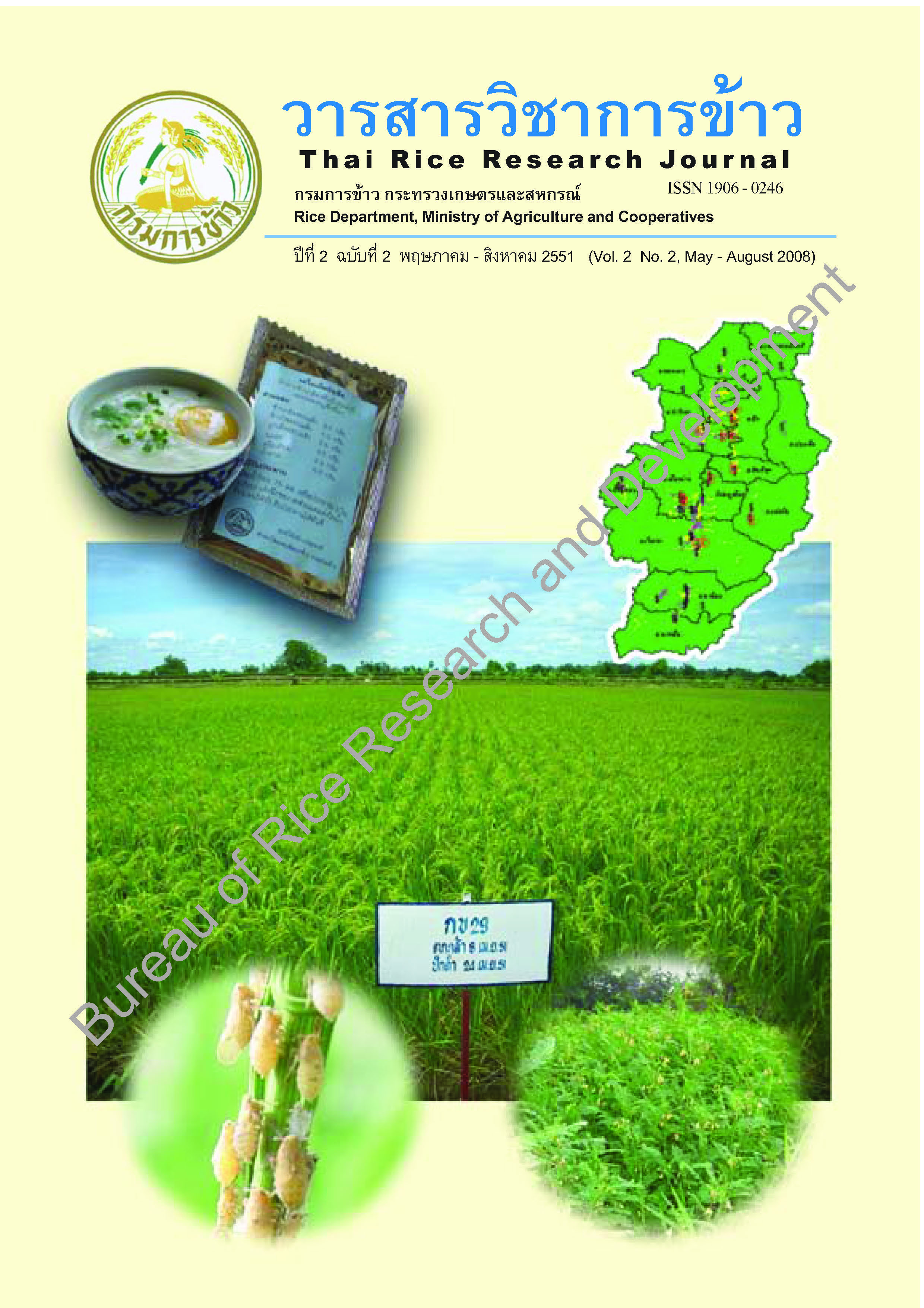RD29 (Chainat 80) Rice Variety
Main Article Content
Abstract
Farmers in the irrigated area of lower northern Thailand require early maturing variety with resistance to major diseases and insect pests and high quality grain according to market demand so that it can be planted 3 times/year for commercial purposes. Therefore, this research project aimed at developing rice variety to meet the farmers' requirement. The research was conducted in 1989 at Chainat Rice Experiment Station. A variety RD29 (Chainat 80) was derived from 3-way cross of the cross between F1 hybrid of Suphanburi 60 and IR29692-99-3-2-1 and IR11418-19-2-3. Progenies of the crosses had been selected for good performance in intra-station yield trial, inter-station yield trial, farmers' field trial and yield stability evaluation. They were also tested for resistance to major diseases and insect pests, grain physical and chemical qualities, and response to nitrogen fertilizer. The results showed that RD29 is photoperiod insensitive variety. The prominent characteristics of this variety are early maturing of 99 days in dry season and 103 days in rainy season; yield of 876 kg/rai which were 6 and 18% higher than that of Suphanburi 1 and Chainat 1, respectively. RD29 showed good yield stability, moderately resistant to brown planthopper and bacterial leaf blight, non-glutinous long grain rice, less chalkiness and good milling quality. In addition, its brown rice contains 15.7 mg/kg of Fe. It is suitable for growing under irrigated condition in the lower northern region because it can be planted 3 crops/year starting from August, December and April but could not suitable for growing at the mid-September until the end of November because low temperature result in unfilled grain and low yield. RD29 is susceptible to brown planthopper in Nakhon Pathom, Pathum Thani, Ratchaburi, and Chachoengsoa provinces. Therefore, planting this variety in these provinces need more intensive care than other cultivated areas.
Article Details
References
กรมวิชาการเกษตร. 2530. เอกสารแนะนำพันธุ์พืชของกรมวิชาการเกษตร. 256 หน้า.
งามชื่น คงเสรี. 2542. คุณภาพข้าวสารและข้าวสุก. หน้า 22-24 ใน: การอบรมหลักสูตรการวิเคราะห์คุณภาพข้าวหอมมะลิทางเคมี โดยศูนย์วิจัยข้าวปทุมธานีสถาบันวิจัยข้าว กรมวิชาการเกษตร 24-25 มีนาคม ศูนย์วิจัยข้าวปทุมธานี. จ. ปทุมธานี.
ทัศนีย์ สงวนสัจ. 2540. บทบาทของพันธุกรรมต้านทานโรคและแมลงกับการปรับปรุงพันธุ์ข้าวไทย. ศูนย์วิจัยข้าวพิษณุโลก สถาบันวิจัยข้าว กรมวิชาการเกษตรกระทรวงเกษตรและสหกรณ์. 174 หน้า.
พีระศักดิ์ ศรีนิเวศน์. 2526 ก. พันธุศาสตร์ ปริมาณที่เกี่ยวข้องกับการปรับปรุงพันธุ์พืช. ว.วิทย. กษ. 16 (4) : 340-346.
__________. 2526 ข. พันธุศาสตร์ ปริมาณที่เกี่ยวข้องกับการปรับปรุงพันธุ์พืช. ว.วิทย. กษ. 16 (5) : 409-422.
สถานีทดลองข้าวสุพรรณบุรี. 2537. พันธุ์ข้าวสุพรรณบุรี 2. ข้อมูลเสนอคณะกรรมการวิจัยและพัฒนา กรมวิชาการเกษตร เพื่อพิจารณาเป็นพันธุ์รับรอง สถานีทดลองข้าวสุพรรณบุรี , สถาบันวิจัยข้าว กรมวิชาการเกษตร. 24 หน้า.
สำนักงานสถิติการเกษตร. 2548. สถิติการเกษตรของประเทศไทย ปี 2547. ศูนย์สารสนเทศการเกษตร. สำนักงานสถิติการเกษตร. กระทรวงเกษตรและสหกรณ์. 122 หน้า.
Eberhart, S.A. and W.A.Russell. 1966. Stability parameters for comparing varieties. Crop Science 6 : 36-40.
IRRI. 1996. Standard Evaluation System for Rice. 4th ed. International Rice Research Institute. Los Banos, Philippines. 49 p.
Jennings, P.R., WR. Coffman and H.E. Kauffman. 1979. Rice Improvement. International Rice Research Institute, Los Banos, Philippines. 186 p.
Khush, G.S. 1979. Genetics and breeding for resistance to brown planthopper. pp. 321-332. In : Brown Planthopper : Threat to Rice Production in Asia. IRRI, Los Banos, Philippines.
Khush, G.S., D. J. MacKill and G.S. Sidhu. 1989. Breeding rice for resistance to bacterial blight. pp. 207 - 217. In : Baterial Blight of Rice. Proc. Int. Workshop Bacterial Blight Rice. IRRI, Manila, Philippines.
